![]() The Timeline view displays all the branches of your document that contain time information in chronological order along a horizontal time axis. The different timescales available (standard, historic, geological, daily and weekly) let you represent a variety of different events, such as the planning of a product launch, the life cycle of a bee or the rise and fall of an ancient civilization.
The Timeline view displays all the branches of your document that contain time information in chronological order along a horizontal time axis. The different timescales available (standard, historic, geological, daily and weekly) let you represent a variety of different events, such as the planning of a product launch, the life cycle of a bee or the rise and fall of an ancient civilization.
![]() The date formats you see in MindView will depend on your computer's settings.
The date formats you see in MindView will depend on your computer's settings.
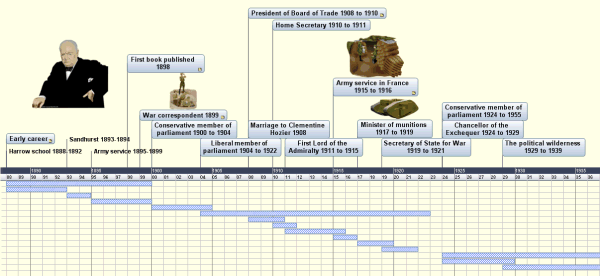
You can access the Timeline view in different ways:
 To create a new timeline from scratch, click the File tab and choose New | Timeline.
To create a new timeline from scratch, click the File tab and choose New | Timeline.
 Choose a timescale from your map in the Select Timescale dialog that opens. For information about the different timescales available, see "Inserting timeline data".
Choose a timescale from your map in the Select Timescale dialog that opens. For information about the different timescales available, see "Inserting timeline data".
You can also display an existing map in timeline form in the Timeline view. To do this:
 Choose Home | View | Timeline or View | View | Timeline in the main menu, or
Choose Home | View | Timeline or View | View | Timeline in the main menu, or
 Right-click the workspace and choose View Map as Timeline in the local menu, or
Right-click the workspace and choose View Map as Timeline in the local menu, or
 Press Ctrl + Shift + 4.
Press Ctrl + Shift + 4.
Going to the Timeline view from another view only affects the way the mind map is displayed. The contents of the mind map are not modified, unless you edit them yourself while working in the Timeline view.
![]() You can quickly switch map views by right-clicking the workspace and selecting the desired view in the floating toolbar that appears above the right-click menu. The floating toolbar also contains other options relevant to the selected view.
You can quickly switch map views by right-clicking the workspace and selecting the desired view in the floating toolbar that appears above the right-click menu. The floating toolbar also contains other options relevant to the selected view.
![]()
As all the other views, the Timeline view is made up of several components:
 The Timeline Outline
The Timeline Outline
This panel, which is displayed by default on the left of the Timeline view, shows all the branches of your map as a hierarchical list which you can expand and collapse as required.
All the branches are listed, including those that do not contain time information.
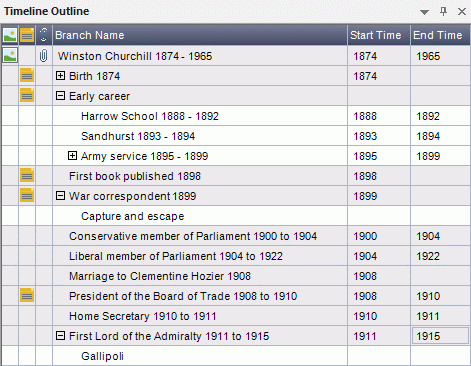
The Timeline Outline works exactly as the main Outline view.
You can close the Timeline Outline by clicking its Close icon ![]() . To re-open it, choose View | Timeline Outline in the Timeline Tools tab.
. To re-open it, choose View | Timeline Outline in the Timeline Tools tab.
![]() You can also click the Auto Hide pin
You can also click the Auto Hide pin ![]() to make the Timeline Outline only appear when you hover its tab on the left side of the workspace.
to make the Timeline Outline only appear when you hover its tab on the left side of the workspace.
 The Timeline
The Timeline
The Timeline area shows all the branches of your map that contain time information, arranged in chronological order along a time axis.
All the branches and sub-branches that contain time information are represented, regardless of the hierarchical structure of the map.
Note that if none of your branches contain time information when you switch to Timeline view, the timeline will be empty.
 The Task/Timeline Panel
The Task/Timeline Panel
This panel is displayed on the right of the workspace. It lets you define the timescale of your document and enter time information on its branches.
Both of these operations are described in detail in the topic "Inserting timeline data".
As well as using the Task/Timeline panel, you can also enter time information for your branches directly in the Timeline Outline or in the main Outline view.
If the Task/Timeline panel is not visible, click the Task/Timeline tab on the right of the workspace or choose View | Show/Hide | Panels | Task/Timeline Panel.
 The Timeline Tools Tab
The Timeline Tools Tab

This toolbar appears as soon as you switch to the Timeline view. Its icons allow you to perform various actions on your timeline, as described below.
The Timeline Outline shows all the branches of your map, including those that do not contain time information. The timeline itself however only shows the branches containing time information.
The branches are listed in the Timeline Outline in their order of creation. This means that if you created them in another view such as the Mind Map view, they will be listed in the Timeline Outline in the same order as in the Mind Map view (going clockwise from the top right), rather than in chronological order.
Selecting a branch in the Timeline Outline automatically selects it on the timeline. If necessary, the timeline is scrolled to bring the branch into view. Conversely, selecting a branch on the timeline selects it in the Timeline Outline.
The Timeline Outline looks and works exactly as the main Outline view. When working in the Timeline Outline, you can for instance:
 Add, delete, move, cut, copy and paste branches in exactly the same way as in the main Outline view.
Add, delete, move, cut, copy and paste branches in exactly the same way as in the main Outline view.
 Add branch pictures, icons, text notes and pop-up comments to any of your tasks.
Add branch pictures, icons, text notes and pop-up comments to any of your tasks.
 Attach objects such as text files, video files, sound files, hyperlinks and so on.
Attach objects such as text files, video files, sound files, hyperlinks and so on.
For a description of the Outline view and how to perform these operations, see "Using the Outline view".
You can enter time information on a branch from the Timeline Outline by double-clicking the relevant Start Time or End Time cell (or pressing F12 or Ctrl + F12 respectively) and filling in the time picker as described in "Inserting timeline data".
Any change you make in the Timeline Outline is immediately reflected on the timeline itself.
By default, the timeline shows all the branches of your map that contain time information arranged in chronological order along a time axis.

MindView lets you define the visual aspect of your timeline at any time by applying design options to it.
 Click the Design tab at the right of the ribbon.
Click the Design tab at the right of the ribbon.
 Browse through the Layouts gallery to choose your preferred layout.
Browse through the Layouts gallery to choose your preferred layout.
 Browse through the Styles gallery to choose your preferred style.
Browse through the Styles gallery to choose your preferred style.
 (optional) To further customize the visual aspect of your timeline, explore the options available in the Effects and Properties panels.
(optional) To further customize the visual aspect of your timeline, explore the options available in the Effects and Properties panels.
As well as using the Timeline Outline, you can enter events (branches) directly on the timeline itself:
 Double-click the workspace.
Double-click the workspace.
 Fill in the relevant details in the Insert Event dialog and click OK.
Fill in the relevant details in the Insert Event dialog and click OK.
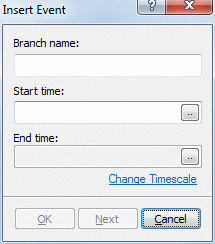
The branch is now inserted at the correct place in the timeline.
![]() Clicking Next instead of OK keeps the dialog open, ready for you to insert more branches.
Clicking Next instead of OK keeps the dialog open, ready for you to insert more branches.
MindView also lets you move branches on the timeline by dragging them to a different start time. Note that if an end time had been specified for the branch, this end time is also moved so that the duration remains the same.
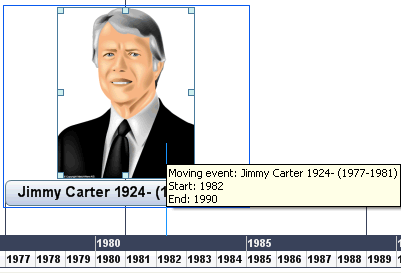
![]() For more precise positioning, double-click the relevant Start Time or End Time cell in the Timeline Outline (or press F12 or Ctrl + F12 respectively) to open the time picker.
For more precise positioning, double-click the relevant Start Time or End Time cell in the Timeline Outline (or press F12 or Ctrl + F12 respectively) to open the time picker.
When working in the Timeline view, you can add icons, pictures, text notes, comments and branch connections on any of the branches displayed in the timeline, just as in all the other views. You can also attach objects such as text files, video files, sound files and hyperlinks.
 Select the required branch on the timeline.
Select the required branch on the timeline.
 Choose the relevant command, using either the main menu or the local menu of the branch.
Choose the relevant command, using either the main menu or the local menu of the branch.
For more information on these procedures, see the topics "Inserting icons", "Inserting pictures", "Inserting text notes", "Inserting comments", "Attaching objects", "Creating hyperlinks" and "Creating branch connections".
 To display the start and end times of the timeline events underneath their label, choose View | Data | Show Branch Data
To display the start and end times of the timeline events underneath their label, choose View | Data | Show Branch Data ![]() (or right-click the workspace and choose Show Branch Data) and check Start/End time in the sub-menu.
(or right-click the workspace and choose Show Branch Data) and check Start/End time in the sub-menu.
![]() You can then hide or show the time information on individual branches with the Show Branch Data icon of the Format tab (or the Show Branch Data option in the branch local menu).
You can then hide or show the time information on individual branches with the Show Branch Data icon of the Format tab (or the Show Branch Data option in the branch local menu).
 If you have entered both a start time and an end time for a particular event, you can show the duration of this event as a bar below the time axis by clicking View | Show Duration Bars in the Timeline Tools tab.
If you have entered both a start time and an end time for a particular event, you can show the duration of this event as a bar below the time axis by clicking View | Show Duration Bars in the Timeline Tools tab.
 You can view pop-up comments and attached objects by clicking the comment icon
You can view pop-up comments and attached objects by clicking the comment icon ![]() or paperclip icon
or paperclip icon ![]() just as in the other views.
just as in the other views.
 You can use the Bookmarks feature to set bookmarks on your timeline in order to locate events quickly again. See "Viewing a mind map" for more information.
You can use the Bookmarks feature to set bookmarks on your timeline in order to locate events quickly again. See "Viewing a mind map" for more information.
 You can use the Smart Nav toolbar to quickly navigate your timeline using four handy tools. See "Viewing a mind map" for more information.
You can use the Smart Nav toolbar to quickly navigate your timeline using four handy tools. See "Viewing a mind map" for more information.
 The Numbering Scheme icon
The Numbering Scheme icon ![]() of the Timeline Tools tab or Home tab lets you apply sequential numbers to the branches of the Timeline according to their order in the Timeline Outline. When your timeline has several levels of branches, it will help you identify which main branch the different sub-branches belong to.
of the Timeline Tools tab or Home tab lets you apply sequential numbers to the branches of the Timeline according to their order in the Timeline Outline. When your timeline has several levels of branches, it will help you identify which main branch the different sub-branches belong to.
 As in the other views, you can also use the Apply Branch Focus icon
As in the other views, you can also use the Apply Branch Focus icon ![]() of the View tab to restrict the display to a particular branch. Click the Clear Branch Focus icon
of the View tab to restrict the display to a particular branch. Click the Clear Branch Focus icon ![]() to view the entire timeline again.
to view the entire timeline again.
![]() If the branch you selected does not have any sub-branches, or if its sub-branches do not contain time information, the timeline will be empty.
If the branch you selected does not have any sub-branches, or if its sub-branches do not contain time information, the timeline will be empty.
For more information about this procedure, see the topic "Focusing on a branch" of the "Further tasks" section.
 Finally the Filter icon
Finally the Filter icon ![]() of the View tab lets you hide all the timeline branches that do not meet the filter criteria you have defined. You can also use the Highlight icon
of the View tab lets you hide all the timeline branches that do not meet the filter criteria you have defined. You can also use the Highlight icon ![]() to highlight branches that meet the filter criteria but still keep the rest of the branches visible.
to highlight branches that meet the filter criteria but still keep the rest of the branches visible.
For more information about this procedure, see the topic "Filtering a mind map" of the " Further tasks" section.
You can change the level of magnification of your entire timeline as follows:
 Click the Zoom In icon
Click the Zoom In icon ![]() of the Zoom slider shown in the bottom right of the workspace (or press Ctrl + "+") to increase the level of magnification of your timeline.
of the Zoom slider shown in the bottom right of the workspace (or press Ctrl + "+") to increase the level of magnification of your timeline.
When you zoom in, everything gets bigger, including the text, the boxes and the pictures included on your timeline.
 Click the Zoom Out icon
Click the Zoom Out icon ![]() (or press Ctrl + "-") to decrease it.
(or press Ctrl + "-") to decrease it.
When you zoom out everything gets smaller.
 Choose View | Zoom | Fit All
Choose View | Zoom | Fit All ![]() or press F4 to see the entire timeline.
or press F4 to see the entire timeline.
You can also view your timeline in full screen mode, to give it as much screen space as possible:
 Choose View | Zoom | Full Screen
Choose View | Zoom | Full Screen ![]() or press F9.
or press F9.
 To return to normal viewing mode, choose Close Full Screen in the floating Full Screen toolbar, press Esc or press F9 again.
To return to normal viewing mode, choose Close Full Screen in the floating Full Screen toolbar, press Esc or press F9 again.
See "Zooming in and out" for more information on zooming.
You can also increase or decrease the level of detail on the time axis as follows:
 To increase the scale on the time axis, click View | Expand in the Timeline Tools tab.
To increase the scale on the time axis, click View | Expand in the Timeline Tools tab.
 To decrease the scale, click View | Compress.
To decrease the scale, click View | Compress.
Expanding the scale makes the timeline less crowded as a given period of time occupies more horizontal space. As a result, you may start seeing more detail on the time axis. For instance, instead of having ticks every 5 years, you might now have a tick for every year. As you continue expanding the scale, you might see months and days appear on the time axis.
Events on the timeline do not change size when you expand the scale: they move apart horizontally, and they may also move vertically nearer the time axis as more space becomes available. Contracting the scale has the reverse effect.
You can also replace empty space on the time axis with one or more break marks by clicking View | Show Time Breaks in the Timeline Tools tab.
This optimizes the use of the horizontal space when events are not evenly distributed along the timeline.
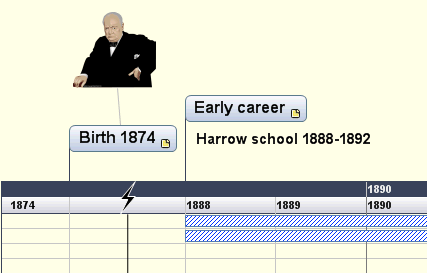
 To remove these time breaks, just click the icon again.
To remove these time breaks, just click the icon again.
When working in the Timeline view, the only export methods available are:
 Export to HTML
Export to HTML
This export method works in exactly the same way as when you export the document from one of the standard Mind Mapping views. The only difference is that the Home page of your web site contains an interactive view of the timeline, allowing you to display each of its pages with a simple click wherever the mouse pointer changes to a hand. A Timeline button is inserted in all the pages of the site to let you return quickly to this interactive view.

For more information about this export method, see "Exporting to HTML".
 Export to Microsoft Outlook
Export to Microsoft Outlook
For more information about this export method, see "Exporting to Microsoft Outlook task list".
 Export to Microsoft Project
Export to Microsoft Project
For more information about this export method, see "Exporting to Microsoft Project".
 Export to XML
Export to XML
For more information about this export method, see "Exporting to XML".
 Export to picture
Export to picture
For more information about this export method, see "Exporting as picture".
You can print your timeline in the same way as in the Map views.
MindView enables you to spread your printout on several pages, which is very useful in the case of timelines. Increasing the horizontal page spread number, for instance, will allow you to create a legible printout of your entire timeline, spread over several pages.
For a full description of the printing options, see "Printing a mind map".